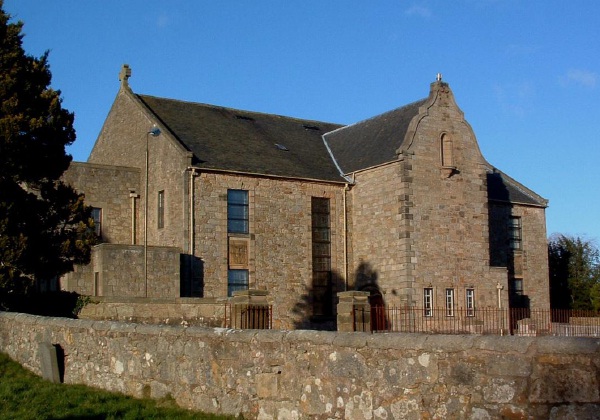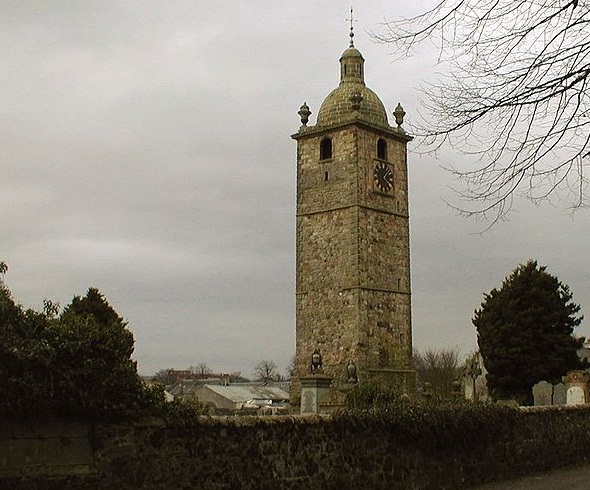|
 “The memory of great men is no less useful
than their presence.”
George, 4th Earl of Winton. “The memory of great men is no less useful
than their presence.”
George, 4th Earl of Winton.
The Seton's of Touch and
Tullibody, and Gargunnock, and Burial at St. Ninian's.
The remains of the old parish church
of St. Ninian's occupies a site which has been in continuous ecclesiastical use,
since at least the mid-12th century. There was a church here by the middle of
the 12th century and the small, weathered, 10th or 11th century cross in the
churchyard suggests that the site was in use before this.
The parish church of Eccles, as it
was first called, is mentioned in a document of about 1150, while about a
century later it is referred to as the church of St. Ninian of Kirketoun, a name
which the village retained until the 18th century. In 1746, the church was used
as a powder magazine by the Jacobite army, and on its retreat an explosion
completely destroyed most of the building, and the Seton Monuments along with
it.
Of the churches that presumably
succeeded each other on the same site, there survive only part of a detached
pier with its capital, the E portion of the chancel, and the steeple which is
virtually intact. This latter was begun in 1734. Taken together, however, the
remaining evidence suggests that the church of 1746 consisted of an aisled nave
of 15th century date to which a square-ended chancel was added in the first half
of the 16th century.
The steeple replaced an earlier
tower in the same position. The chancel remains standing 99'10" E of the
steeple; built of sandstone ashlar, it measures 25'2" x 25'6" over 2'10" thick
walls. A burial aisle, which still survives, was added to the N of the chancel
about 100 years after the chancel was erected. It measures 10'11" x 16'5".
Apart from the tower the remains of the church blown up in 1746, are fragmentary
and show no features of earlier than the 15th century.
 St.
Ninians is a long-standing settlement which is now a district of the city of
Stirling in central Scotland, and is located approximately one mile south of the
city centre. St.
Ninians is a long-standing settlement which is now a district of the city of
Stirling in central Scotland, and is located approximately one mile south of the
city centre.
It was originally known as Eccles (ie. 'church'), and may have been a Christian
site from an unusually early date (possibly 5th or 6th century). Later called
'St. Ringan's' (a variant of St Ninian's). This church was the administrative
centre for churches across the strath of the River Forth.
In the aftermath of the 1745 Jacobite Rising, the retreating army of Bonnie
Prince Charlie blew up the church of St. Ninians where they had been storing
munitions; only the tower survived and can be seen to this day.
In recent years the old steeple
which was built in 1734 but houses a 17th century bell, became structurally
unsafe, however it has been restored with funding from St. Ninians Old
Parish Church, local community donations, and Historic Scotland. As it stands,
this tower appears to be a late 17th to early 18th century structure, but is
likely to be of much earlier origin, and possibly from the remains of the
11th-12th century tower that existed.
The the Seton's of Touch monuments
were destroyed, there is still the memorials and burials of the Seton-Steuarts
in the cemetery adjacent.
With regards to repair of the Church
of St Ninian's, A reply-letter from A Seton to John Watsone:
"seeking the recipient's proportion
of the expense. He wishes information concerning the work undertaken and what is
now proposed; alterations to the Plan of the Kirk. 'One alteration of the Plan
of the Kirk is to bring the pulpit forward to the middle of the Kirk on account
of the pillars that are put up because they will hinder the Minister's slight of
the people and of them from seeing him also....."
The writer disagrees with this
proposal made by Mr Glass. Includes a letter from William Murray to William
Wilsone.
| 
